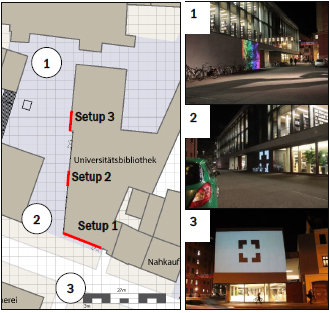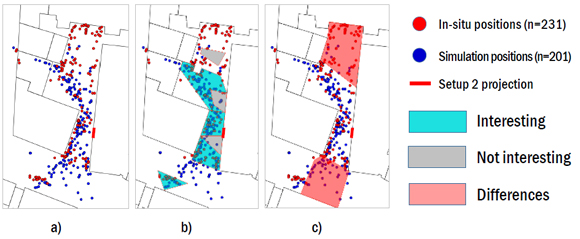In-Situ vs. Simulation-Based Experience Evaluation of Media Augmented Urban Environments
Publication
Introduction
Architectural elements and spatial configurations influence how we experience interactive systems in urban environments. In this study we explored, how visual content is experienced within the city. We investigated how basic content types (moving text, basic shapes, images) in different architectural configurations shape viewer’s experience. This was done in an in-situ field study. Carrying out the in-situ study led to the question, if experiences need to be to evaluated in-situ or whether a simulated urban environment might create similar insights.

The figure above shows the three major types of content tested: text (static and moving at different speeds), basic shapes based on Gestalt Principles, and simple images (e.g. the tree) at different resolutions and pixel pitches.
Two Experimental Methods
How to evaluate experience in a Media Augmented Urban Environments? We tested two different methods: Experiential Sampling (ES) for which we selected five visually interesting sampling locations at which test participants fill in a questionaire with a set of sematic differentials each. The Free-to-Roam(FTR) method asked participants to freely wander the setting and explore the Display Space of the projection and note down visually interesting impressions.
Settings
Setup 1: The projection is faced towards a hybrid setting consisting of a mix of walkways and plazas. The façade can be seen from very far away. The visual field is not very coherent, but complex. A rich set of experiences are possible.
Setup 2: Transitory area which resembles a narrow walkway passage. It restricts the mediums reach by building edges and forces passers passers-by to cross ones social space.
Setup 3: Plaza-like setting in contrast to the walkway-like setting in setup 2. Each setting creates its own situation.


Visual Examples
The images below exemplify only on a visual level the impact of environment on perception of the projection. The bodily (spatial) experience can only be recreated in-situ. Left: Inscribed projection into street’s field of view. Right: Extreme angle of view and visual influences of existing other media (e.g. traffic lights)

Comparisson
Why may it be necessary to use simulation? In many cases a field study is expensive – it takes time, requires specific equipment and needs
adequate conditions (i.e. temperature, daylight, etc.).
For the comparison of in-situ (left) and simulation-based (right) evaluation we used the FTR method in setup 2.
The area is compact and at the same time has a variety of viewing positions.

a) Indicates positions where notes were taken by the participants. b) Shows areas that were percieved as interesting in-situ as well as in simulation testing. c) Areas in which the number of notes varied considerably.

Results

We consider simulation to be an additional tool, which can support some ideas, provide preliminary results and serve as preparatory step before an in-situ test.Improvements are possible in directions of optimizing the in-situation data collection process and evaluation (e.g. usage of digital notes collector and other interactive equipment for flexible work with projection content) as well as the direction of enhancing the simulator environment and functionality (e.g. usage of virtual reality for a better immersion and including more intelligent tools, like copying functionality for repeated vista positions/feelings, screen view saver, etc.). Additionally it is worth to investigate the effect of an map overview on the distribution of note taking points during the simulation test.
Future Work
Improvements are possible in directions of optimizing the in-situation data collection process and evaluation (e.g. usage of digital notes collector and other interactive equipment for flexible work with projection content) as well as the direction of enhancing the simulator environment and functionality(e.g. usage of virtual reality for a better immersion and including more intelligent tools, like copying functionality for repeated vista positions/feelings, screen view saver, etc.). Additionally it is worth to investigate the effect of an map overview on the distribution of note taking points during the simulation test.
Reference:
Ekaterina Fuchkina, Patrick Tobias Fischer, Chinh Nguyen Tien, Anke von der Heide, Eva Hornecker. In-Situ versus Simulation-Based Experience Evaluation of Media Augmented Urban Environments. Adjunct Proc. of UbiComp'16 the ACM International Joint Conference on Pervasive and Ubiquitous Computing, pp. 65-68.
Research Team:
Patrick Tobias Fischer
Anke von der Heide
Ekaterina Fuchkina
Chinh Nguyen Thien
Eva Hornecker
